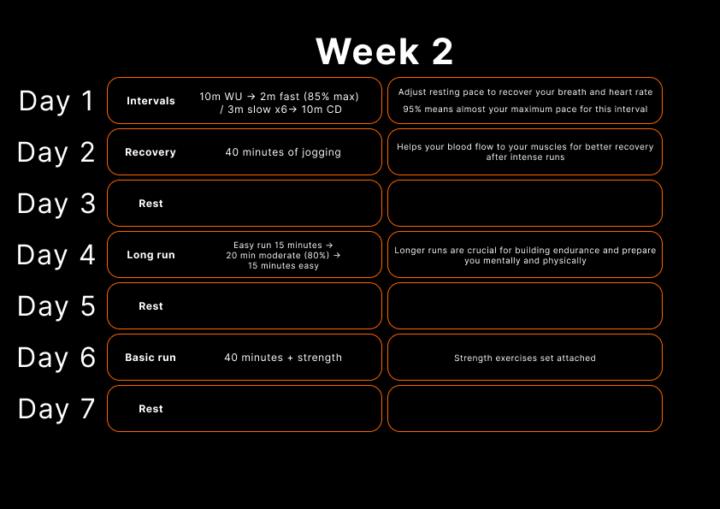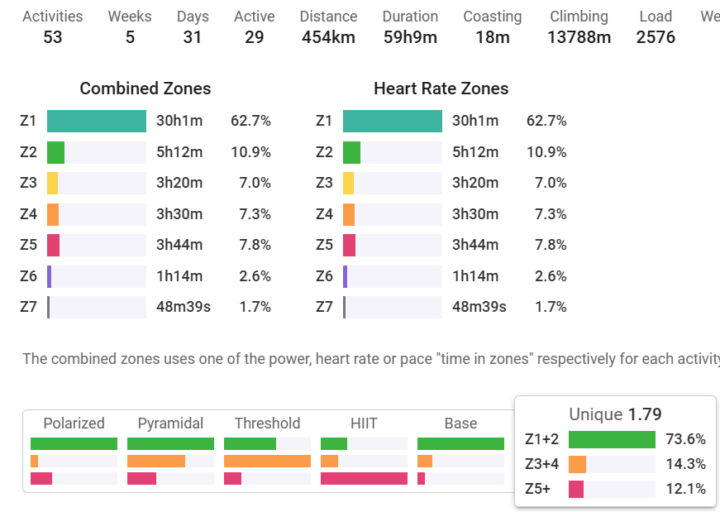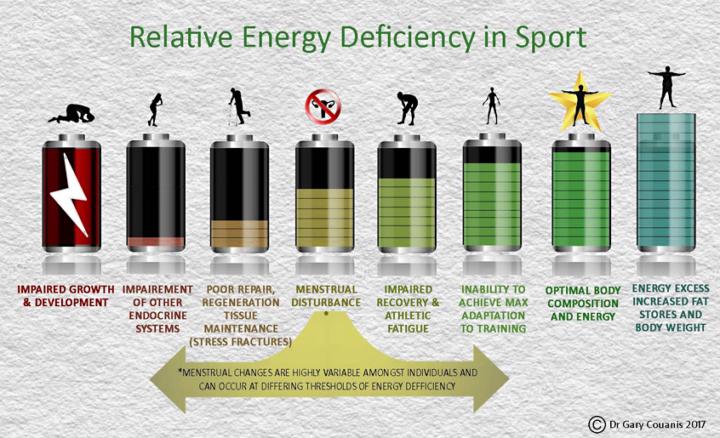Activity
Mon
Wed
Fri
Sun
Jan
Feb
Mar
Apr
May
Jun
Jul
Aug
Sep
Oct
Nov
Dec
What is this?
Less
More
Owned by Josh
Enter the Gym Owners Guild! A fellowship of fitness entrepreneurs on a quest for gains and glory. Join us and level up your business.
Memberships
Profit Creators
20 members • Free
YouTube Acquisition
1.2k members • Free
Scale Your Coaching
21k members • Free
The Passion 2 Profit Formula
225 members • $120/m
Next Level Man
32 members • Free
The Dino Chasers
13 members • Free
Better Runner
44 members • Free
WavyWorld
40.5k members • Free
Warrior Society
196 members • Free
8 contributions to Better Runner
Running Challenge Week 2
🎖️Congratulations to all of you who have taken the first steps towards consistent and smart running! There are not many of us, but I am sure that those who have started today will achieve their running goals! The hardest thing is to develop consistency and the first step is already behind us! If you didn't have time, start later - you can still join from the week 1 - I will help you to synchronise your days so that everyone moves more or less together. ☺️ 👇Here is the plan for you 👇 DAY 1 START : TODAY This week intensity and volume is a bit higher ! Strength Set stays the same 👌 Strength exercises for day 6 https://www.skool.com/become-better-runner-4238/no-equipment-strong-legs-for-runners-prepost-run-set?p=ef3ce2fc

Could it be that creatine helped me to run my fastest 10k?
If you’ve heard of creatine, the first thing that pops into mind when you hear that word is a big muscle guy pumping iron in the gym. But creatine is the most studied sports supplement known. This gives us a lot of research that confirms that creatine can be beneficial for runners as well. Now, looking back in the last summer I took creatine for 2 months just before my racing season. My goal was to do 10 pull-ups and did a lot of weight training. I would say too much for a runner. ( sometimes I get obsessed with some not-running related goals😆) My running volume was pretty low for a typical runner competing at that level. (220-230km/ month) But for some reason I felt the strongest this season and ran two 10k races in under 38 minutes (3.45min/km) Cutting off almost 3 minutes from my previous PB🤯 The conclusion for this result is complex. Maybe creatine helped, maybe strength training in general. The right training volume distribution. But I felt that my muscles were just sharp, powerful, reactive. 🔬 What the Research Shows: ➡️Boost Sprint Performance - Improves repeated sprint performance by enhancing ATP regeneration ➡️Enhancing Glycogen Storage - When paired with carbs, creatine boosts muscle glycogen storage—key fuel for marathon/ultra training ➡️Supports Recovery - Reduces muscle damage/inflammation post-long runs (lowers creatine kinase and inflammatory markers). - Acts as an antioxidant to combat oxidative stress from endurance training 👇Summary of creatine benefits for running performance👇 - Trail/mountain running (frequent elevation changes) - Races with tactical surges (e.g., breaking away from the pack) - Finishing kicks (last 400m of a 5K/10K) - High-intensity interval training (HIIT/repeats) What about me? I will test the creatine theory again. What about you? Did you know that it is a good supplement even if you just want to improve brain function and general health?

There’s a time to accumulate. And a time to perform.🎯
Even if you are an amateur athlete, you cannot be in peak form all year round. There is a time to work hard, to use your willpower, to push yourself to the limit. And there is a time to take it easy and work patiently on your weaknesses. Most of the races take place in the summer/autumn season, so winter is the time to build the foundation - long runs, strength, aerobic capacity - creating lots of new mytochondria working in low intensity HR zones. In endurance sports this is called periodisation. A series of training cycles that correspond to our ultimate goal. I just want to show you a graph of my training volume over the last 3 months. I am not at my peak - I am just laying the foundations for next year's season. This means that I am not spending much time on intensive running - most of my sessions are on the Z1-Z2 HR. When I say most I mean 80-90% of running duration. The statistics are great - I love them. Amazing tool available nowadays that allows to have a deeper understanding of the process. I can see how I am performing throughout the week and throughout the month. I can zoom out after the season and analyse the work I have done. Here are November, December and January graph of intensity distribution according to time spent in HR zones My Z1 is up to 138 bpm I know you might have lots of questions and this topic is very complex- ask and I will try to explain😄 Run Smart not Hard 😊

1 like • Feb 3
This is vital to being able to proforman at a high level for a long time. Doing to much all the time will ware the body down and more than likely cause injuries. A perfect example of this is David Goggins. He may be the hardest man in the world but he has also had to get both his knees worked on.
No Equipment! Strong legs for runners : pre/post run set
A set that strengthens muscles for running, which can be done outdoors or at home. ⚡Trust me doing this will reduce risk of injury ⚡ If it looks easy? Do 3 laps. Not hard enough? Add weight. ✊😄 Attaching video 👇 - One leg "deadlifts'' - great pre-run exercise to engage the gluteus and hamstring muscles - Walking lunges - if you take shorter steps like in the video you will strengthen the muscles around the knees - Calf raises - you can do it without a platform, you can do it on two legs - an easier version - Deep squat jumps - the advanced version will be a forward jumps - One leg Raises from bench - the lower the bench/platform, the harder the exercise - Single leg Taps - arms work like while running to keep balance Hope this helps to progress in your running journey !🎯
Understanding RED-S 🟥 (Relative Energy Deficiency in Sport)
I first heard about RED-S this summer. While studying to become a running coach, a classmate of mine, who specializes in women’s triathlon, shared an article on the topic with me. At the time, I was in the midst of an exciting phase—training in the mountains and participating in various races. However, after a while, I began to feel increasingly tired, and even my easy runs started to feel like a struggle. After reading the article, it became clear: I was experiencing RED-S. 😔 Now, being knowledgeable about this has changed my understanding of training, nutrition, and recovery, while also raising awareness about this very important topic. It’s estimated that over 40% of professional athletes suffer from RED-S, and the number may be even HIGHER among amateur athletes and fitness enthusiasts. RED-S occurs when athletes consistently burn more energy through physical activity than they consume through their diet. Over time, this energy deficit can lead to a wide range of symptoms, including hormonal imbalances, reproductive issues, insomnia, fatigue, weakened bones, injuries, and a higher risk of anxiety and depression. Many triathletes, runners, and climbers aim to stay lean and maintain their “competition weight” year-round. While weight is important in sports that rely on power-to-weight ratio, insufficient calorie intake to match training demands can lead to fat retention and muscle loss. Irregular or inadequate eating can cause the body to store fat, resulting in RED-S. However, the reasons for reduced calorie intake can be both conscious and unconscious. Statistics on RED-S in Sports - Prevalence: Studies show that 40% of female athletes and up to 25% of male athletes in endurance sports experience RED-S or low energy availability. - High-Risk Sports: Endurance sports like running, cycling, swimming, and rowing have the highest prevalence. For example: - Runners: Up to 50% of elite female runners show signs of RED-S. - Cyclists: Approximately 20-30% of male and female cyclists report symptoms. - Dancers and Gymnasts: Also at high risk due to aesthetic and weight-focused pressures.

2 likes • Jan 29
@Mariam Kipiani i've been in this industry for over eight years now.And i've never heard of this, I've experienced this happening before, but had no idea that there was a name or even such a common occurrence going on into the industry. This is really fascinating. I can't wait to look at more about it. Thank you so much for sharing all this
1-8 of 8
@josh-riggs-2522
Building a community of data-driven fit pros. Gym owner & COO of A.R.I.A CRM. Let's grow together!
Active 47d ago
Joined Jan 17, 2025
Indiana
Powered by


